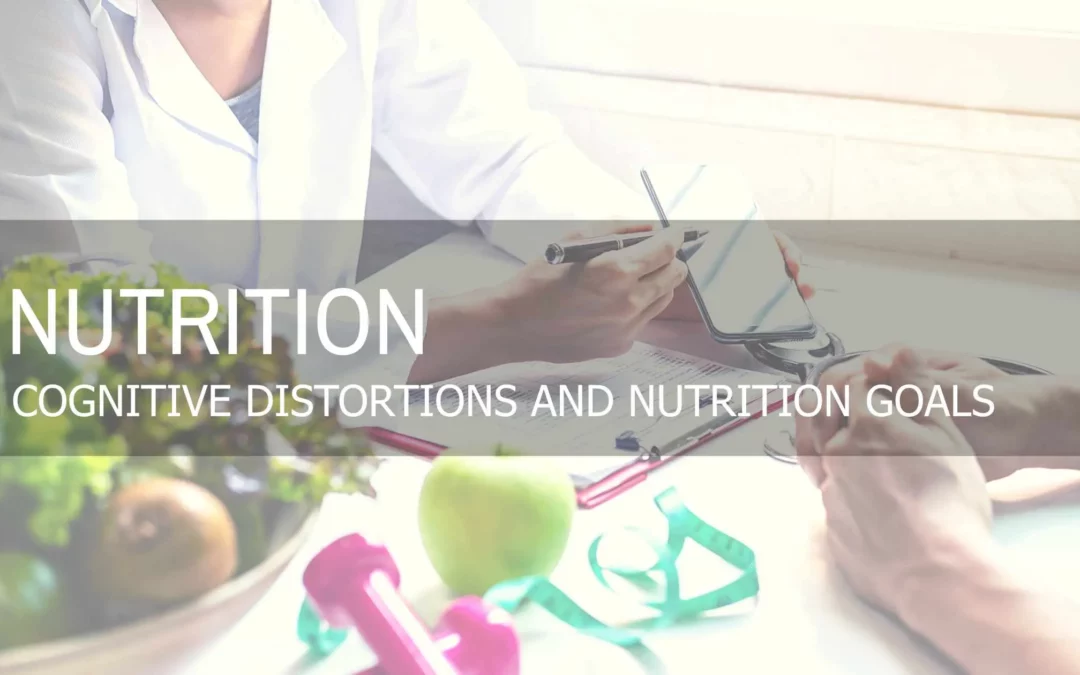Cognitive distortions are perceptual errors in our thinking which lead to misinterpretations of reality, especially about how we relate to the self, others, and the world. Everybody struggles with cognitive distortions from time to time. However, if they become a normal part of our thought patterns, it can cause roadblocks in developing and maintaining healthy nutritional habits.
Five Common Faulty Thinking Patterns That May Hinder Your Nutritional Success
All or Nothing Thinking, or black and white thinking, is when an individual sees things in an extreme “either/or” or binary mindset with little to no room for the grey area. Example: “I need to lose 20 lbs in order to become happy with my life.” “I have to avoid all carbs because they are bad for me.”
When it comes to eating healthy, many of us become so stuck on what the outcome NEEDS TO BE that we tend to frame things into the mindsets of “failure vs. success”. “good vs. bad”, “happy vs. unhappy”. As a result, our happiness and sense of self-worth becomes reliant on the results. So, we tunnel-vision into “desired results” vs. “NOT desired results” and nothing else seems to matter at that moment.
Mental Filter (Selective Abstraction) is a type of faulty thinking where an individual fixates on one negative event to the exclusion of all the positive ones. Example: “I was doing so well, but I ruined my whole diet and exercise program just because I ate that one cookie.”
When we or someone else makes a mistake or slips up, it can be so easy to just focus on that one negative thing while temporarily forgetting about all the positive. Nutritional goals are no different. A common scenario is when an individual is doing quite well on her nutrition goals but then she has a bad day at work and then binge eats her favorite snack. She feels guilty and then proceeds to analyze all her faults. This leads to more binge eating and guilt. The more we focus on the negative, the more we amplify those negative feelings that may lead to self-sabotaging.
Catastrophizing (Maximization) is when an individual extrapolates minor faults or uncomfortable situations to potentially dire consequences or worst-case scenarios. In essence, blowing things out of proportion. Example: I didn’t eat well today. I am a failure. Pretty soon, I am going to die of a heart attack, because research says…”
Good nutrition and a balanced diet are vital, but fretting about following every little nutritional guideline to a tee or reading up on all the latest research can cause us to worry about the inconsequential details. As a result, when some people are hit with unexpected or undesirable information, they become anxious, demotivated, and fear the worst.
Emotional Reasoning is when an individual believes that her emotional reaction is the same as fact and must be true. Example: “I need my candy because it makes me feel good.” “Even though doctors say I am overweight, I think I am healthy, because I feel healthy.”
Part of the reason why habits, especially eating habits, can be hard to break is because we are often skilled at rationalizing our feelings/emotional reactions as fact.
Should Statements are declarations of what one or others, “should”/ “must” do or “ought”/”need” to do, which are often detrimental because those words carry an underlying tone of high expectations (usually unrealistic). Examples: I should only eat fruits and vegetables. “I should lose 50 lbs in order to become happy with my life.”
When we overwhelm ourselves with “should” statements, we often end up adding a lot of pressure and expectations on how we or others should be. As a result, we, ironically, end up disengaging from the things that we think that we should be doing.
What are Some Tools to Help with Cognitive Distortions?
As previously mentioned, everybody struggles with cognitive distortions to some extent. However, a key element behind engaging these faulty thinking styles is that they serve a purpose relative to one’s fears, anxieties, and insecurities. The thinking styles that we engage in are often automatic. So in order to access and restructure current thinking habits, we need to first understand why we think the way we do. Here are a few pointers:
Acknowledge both your successes as well as the areas which you may be struggling with by engaging in mindfulness, self-care (sleep, a day off, alone time), and self-acceptance (both strengths and weaknesses).
Stay aware of the environment and your reactions to it. It can be eye-opening to see what we actually miss when we are on autopilot (mindfulness)For an added challenge and deeper reflection, keep a journal or blog (for at least a couple weeks) to track the most prevalent and significant thoughts throughout the day. Are there any patterns or themes in your thought process that stood out to you? If you wish to delve even deeper into problematic thinking patterns, then a qualified mental health professional who specializes in cognitive behavioral therapy would be a great resource!



